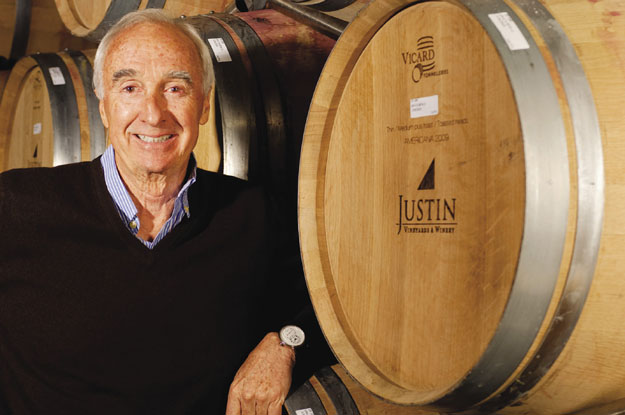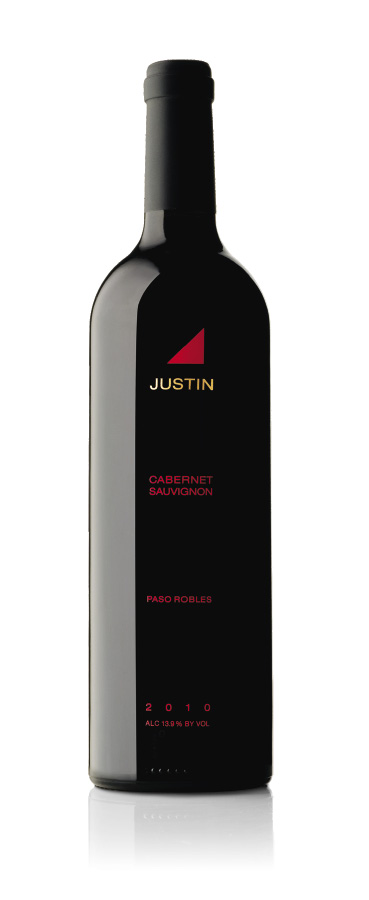![]()
ONLINE
![]()
ONLINE


Justin Baldwin
A Vision for Paso Robles
Editors’ Note
In 1981, former investment and international banker Justin Baldwin founded JUSTIN Vineyards & Winery when he purchased 160 acres west of Paso Robles on California’s Central Coast and planted his estate vineyards. Since its inception, Baldwin has focused his efforts on producing world-class Bordeaux-style blends from the estate vineyards for the JUSTIN label. He is a pioneer in producing this style of wine on the Central Coast and his efforts have been rewarded with past and present vintages earning 90+ points by major wine trade publications. Robert M. Parker Jr. named Baldwin one of his “Wine Heroes of the Year”. Baldwin is a board member of the Family Winemakers of California, the Wine Institute, and a former member of the Paso Robles Wine Country Alliance. For his contributions, Baldwin has been named the Paso Robles Wine Industry Person of the Year and has been made a Commandeur d’ Honneur De L’Ordre Du Bontemps Du Medoc.
Winery Brief
In addition to the vineyards, winery, and tasting room, visitors to the JUSTIN Vineyards & Winery (www.justinwine.com) will find the highly acclaimed country inn, JUST Inn, and its intimate gourmet restaurant, the Restaurant at JUSTIN. JUSTIN is the only winery on California’s Central Coast to retain a full-time chef whose kitchen works daily to pair JUSTIN wines with fresh seasonal and estate grown offerings.
How did JUSTIN Vineyards & Winery come about?
When I went to Paso Robles in 1981, there were eight wineries – today, there are over 200. Hard work was the motivating factor. As a banker, I had opportunities to live and travel around the world and try the best wines. I fell in love with the idea because I grew up in San Francisco and I watched Mondavi develop in the 1960s. At that time, there were only 20 or so wineries in all of Napa – today, there are 450.
I didn’t want to be just another wine guy in Napa or Sonoma. Paso Robles had these fledging wineries and had all the reasons viticulturally for why you could grow good grapes and in turn make good wine. So I invested and bought the land and planted vineyards, and started making wine in the mid-1980s.
Towards the end of that decade, I left my banking job and headed full time into the wine industry. I watched a sleepy town of 8,000 people become one of the most recognized wine regions in the world. Last year, Wine Spectator felt the number one wine in the world was from Paso Robles.
It has always been a labor of love, but it took some foresight, leadership, and applying a business savvy that hadn’t heretofore been applied too often to the wine industry. When you want to make a business out of it, you have to impose the standards that apply to any business. So I did that, and after 30 odd years, we have been very successful in sales and it has been very profitable.

2010 JUSTIN Vineyard & Winery
Cabernet Sauvignon
Working in the wine industry and trying to lead this talented area into the limelight has been the most rewarding thing I could imagine doing. That culminated at the end of 2010 when I sold the business to the largest agricultural family in the state of California. That has taken us to another level not only in terms of quality, sales, and distribution but also in terms of fiscal responsibility, and community responsibility and awareness, and that is even more rewarding.
I’m still very much involved. But it’s a whole new chapter in the winery’s history.
Has it become what you expected when you entered the industry and was your vision received positively from day one?
Yes, because everybody likes the underdog; it helped to not be from a traditional growing region like Napa or Sonoma. There are sound financial reasons why that helped, particularly regarding the cost of land: the start-up costs were less than they would have been elsewhere. We can still sell our product for the same price as our friends up in the North Coast, but our margins are wider because our raw material costs are less, as are capital start-up costs.
My vision was to be self-sufficient, to have my own business, to be a leader within the industry, and to be recognized for the quality product I made, but not to measure in terms of cases, dollars, or sales. And I achieved my objective.
At what stage of the process do you know what that final product is going to be?
Wine is made in the vineyard, so you have to be attuned to what is going on there. If you’re out there during pre-harvest when the buds are starting to break out and miniature grape clusters are forming, you can tell if you had enough rain over the winter months or if it was hot by how the vines wake up; you can tell under what conditions they were asleep over the past six months.
From there, you monitor them during the growing season and you can see if you’re getting the ripeness you need.
After that, the less one interferes, the better. If you’re handed not only a bountiful but high quality harvest, the most minimal involvement is probably going to result in the best quality.
If you don’t get such a good hand, it becomes about what games you can play to tweak it. But it’s probably too late at that stage.
You offer a high level product for a reasonable price. How do you manage that?
It’s tough. But it goes back to the leadership, which is to recognize that it’s a business, and it’s one thing to have an expensive high-profile wine and another to have a well-accepted, widely distributed wine but at a price point that it will sell through and that people will continue to reorder.
In 2009, JUSTIN was the 9th most wine poured by the glass in fine dining restaurants in the U.S and our production is tiny compared to the top five or so above us. So you keep that focus to make it happen.
Is there a right or wrong way to pair wines with food?
It’s like art – you are entitled to your opinion. But there are factors that help you decide which wines to pair with food – it has more to do with texture.
If a food is light, you don’t want to have your wine overpower it and vice versa. White wine has a higher acid content, so that would go with fish, but you also have options with red wines – cabernet franc for example. You chill it down and the acidity level goes up and it becomes a wonderful complement to salmon or tuna.•